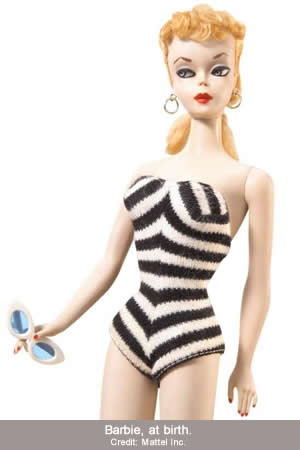Reprinted with permission by Alida Brill*
Whatever the iconic doll has come to mean to little girls around the world, to the author, decades ago, she was a spark to the imagination. Both she and Barbie could be anything—well, just about.![]()

A friend of mine is turning 50 today.
Our friendship was brief but intense. I didn’t get invited to her glitzy celebrity and fashion-hype parties. We don’t run in the same circles any longer.
Although she’s a decade younger than I am she doesn’t change. Her face is flawless. Her eye shadow never smudges down her cheeks. Her manicure is eternally red. She retains a perfectly impossible body.
Everybody knows it’s Barbie’s birthday.
Three hundred thousand clones rolled out on March 9, 1959. Mattel Toy Company conceived her in the American tradition of capitalistic greed and brilliant marketing.
Ruth Handler’s inspiration came from a German doll but was named after her daughter. Christie, an African American doll, did not appear until 1968. Barbie was sexy the way movies depicted women in spike heels and bathing suit. She had no resemblance to any mother I knew. Barbie was my 10th birthday present.
I loved her. She was a woman-doll not a baby-doll.
You didn’t jam a bottle filled with water into Barbie’s mouth waiting for the liquid to hit the baby’s bottom for the thrill of changing a diaper. I knew the water coming out the back was the wrong part of the baby-doll’s anatomy. Barbie’s breasts didn’t impress me. She didn’t have a vagina, but neither did the baby-dolls.
Barbie and I were subversive undercover agents. I assumed I would be a mother, but didn’t want to continue to be in training. I made Barbie do real things. All around me I sensed unhappiness. It wasn’t Friedan’s version described later in The Feminist Mystique. Our community wasn’t that upwardly mobile. Women were unhappy because their lives were hard. They hadn’t expected an American Dream with too many babies and the scramble to put together meals from men who earned wages not salaries.
My escape fantasy was Barbie. On her 40th I wrote she liberated me from believing I would stay where I was forever.
I broke rules with Barbie. She was a doctor. She was an actress, a writer, an explorer. She traveled far away, all alone. She was an “executive secretary.” (I wasn’t completely evolved.) My Barbie got up, dressed, went to work, and had a life. My parents would not and could not invest in Mattel’s many costume changes. I made do with just one. My girlfriend created the rest out of fabric scraps. Billions of Mattel clothing designs later, I think we were fortunate to be among those who created our own stories.
Barbie was my tool to combat stereotypes. When, after two years, Ken came out I was annoyed. Who needed him?
Today the global popularity of the cult of Barbie is linked to eating disorders, consumerism, fashion obsession and just about everything else. Is she the cause or the mirror of cultural confusion?
The fight between the makers of the competitor Bratz dolls and Mattel’s Barbie looks like a school confrontation between the “mean girls” and girls trying to be nice enough to be voted prom-princess. So much has been written about Barbie’s empire and its psychological ramifications.
Why add to the word-glut?
Because Barbie and I are birthday-mates joined together forever 50 years ago, in a month that would eventually become Women’s History Month. An irony I can’t get past. Whether we like it or not, Barbie is a part of many of our personal histories. My original Barbie sits on a bookshelf in my room.
Now she doesn’t challenge. She reinforces stereotypes. In arrogance I thought more had been dismantled during the height of the women’s movement. Is Barbie today’s version of the baby-doll? Is she helping to train girls for roles in individual versions of Sex and the City? Barbie is right in step with too much of what I see in the media. Barbie belongs to our Red Carpet Celebrity Culture that telegraphs to young girls and women that to be important you must be beautiful and famous for being—beautiful and famous—and dreadfully and deathly thin.
Sometimes to remind myself I can’t retire from the advocacy part of my life, I force myself to watch “The Bachelor” on television. I watched the last episode—a self-inflicted form of torture. I fell asleep. In my dream my Barbie watched as the others waited for the rose. The real women looked more like Barbie than my Barbie. Their lips quivered in fear—would Ken choose them? I mean, The Bachelor. My Barbie screamed “Alida, get me out of here! What’s happened?”
In the morning I looked over at my original Barbie, holes in her feet, earrings still in her head. Today truly is her 50th birthday. I noticed her arm was extended defiantly in a gesture telling me to fight on to empower girls and women.
* Alida Brill is an author, social critic and advocate for women and girls. She has written and spoken about the personal and public issues surrounding women and chronic illness, and questions of medical privacy. Her most recent book is Dancing at the River\’s Edge: A Patient and Her Doctor Negotiate a Life With Chronic Illness (Schaffner Press, 2009), a dual memoir with her physician Michael D. Lockshin, M.D.
I felt compelled to reprint this given my less than feminist take on Barbie\’s 50th birthday several posts ago. Still, mine was fun to write. Happy 50th!
Filed under: 1 | Tagged: 1950s, 50 years old, Barbie, flawless beauty, Ken, Mattel Toy Company, Sex and the City, Women's History Month | 1 Comment »
















You must be logged in to post a comment.